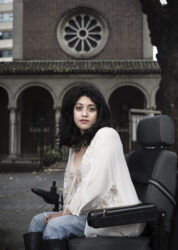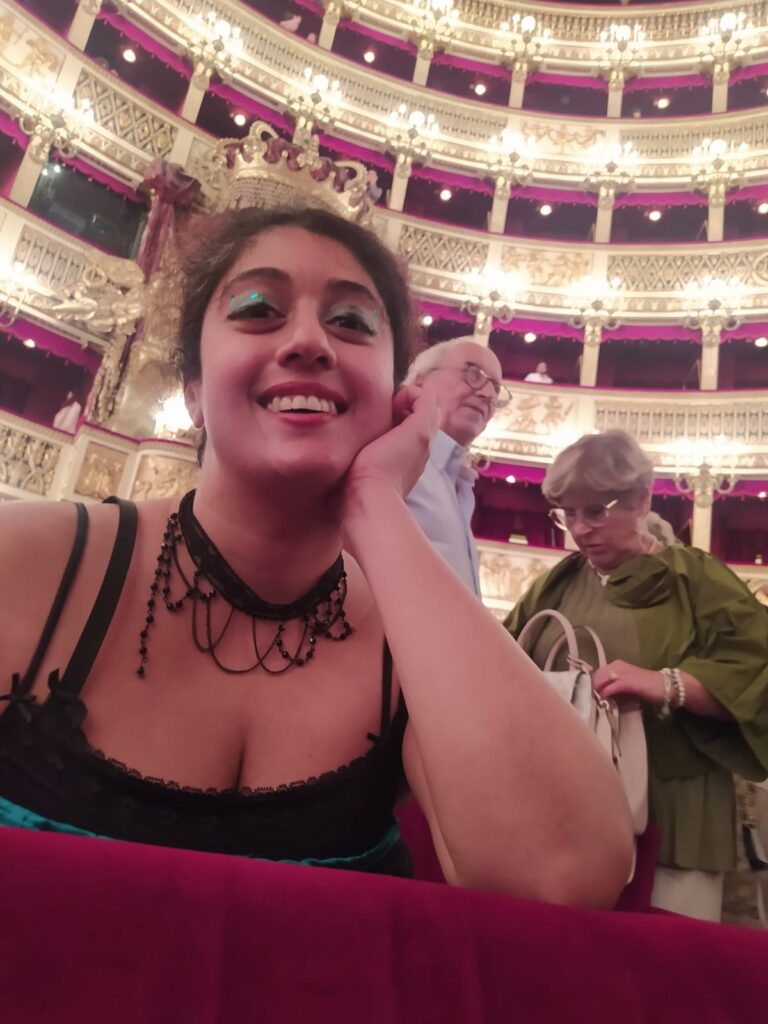
Mistakes I Made Travelling to Italy as a Disabled Person- and how to avoid them
In February 2023, after short trips to Venice and Rome, my partner and I decided to spend a month living in the Eternal City. Since then, Rome is like a lover I simply can’t be parted too long from. Another opportunity arose just six months later to return, an invitation from Disability Pride Network, who run the Disability Pride Parade in Rome- and since learning more about the Grand Tours undertaken by writers like Percy and Mary Shelley, Goethe and Dickens (whose accounts of his travels are shockingly pompous but that’s a story for another day) we decided to turn this into a Grand Tour of our own, starting from Verona to Florence, then to Naples and culminating in the Disability Pride Parade in Rome. We didn’t return to Serene Lady Venice due to the inaccessibility of her bridges- because for all its unforgettable beauty and soul-reviving food, the Bel Paese also throws up many challenges for disabled people.
Below are some of the tips and advice I would give to anyone travelling to Italy, and particularly for people with mobility impairments. Don’t let any of the difficulties we encountered deter you. The more you research before going, the less likely you will be to run into challenges. We know as disabled people that obstacles will always arise, whether at home or on holiday. No matter how upsetting things may get, you will look back and think that it really was all part of the adventure. Tranquilla; you are in the most beautiful country in the world. The next moment some magnificent wonder like the Trevi granting wishes in the moonlight, or a steaming Neapolitan pizza with its toppings sumptuously sliding off the slice as you pick it up to eat, will make it all worth it.
- Don’t Go During High Season (June – September)
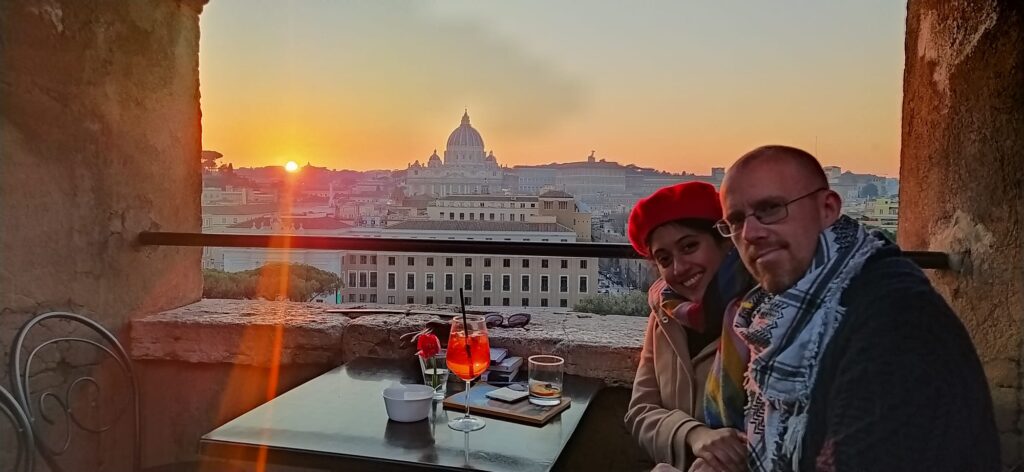
Alt text: Image shows the sun setting beside St. Peter’s Basilica from a window in the castle walls, and a man and woman sitting in front of it, with an Aperol Spritz and Crodino aperitivo at their table.
Alt Text: Image shows the face of a woman with a mischievous grin popping over a large bouquet of artichokes with wilting leaves.
We didn’t realise that September is still High Season in Italy- that means high prices, temperatures and tourist numbers. We went for the Disability Pride Parade, but having spent a month in Rome in February, we saw firsthand the difference, most of all in the price of accommodation- our full month in February worked out much cheaper than our 16 days in Italy during the tail end of the high season in late September.
The month that you absolutely must avoid is August, when the cities effectively close up shop so that Italians can go on their holidays, a phenomenon known as Ferragosto. And while July is Disability Pride Month, the founder of Disability Pride Network Italia, Carmelo, says that they cannot have their parade then as they would not survive the heat- temperatures in these months can sometimes reach over 100 degrees Fahrenheit. Even in September, temperatures were often around 31 degrees celsius- it was shorts, sunglasses and thin dresses all the way.
Personally, I love the summer heat, and travelling in February was a little colder than we expected, mostly cloudy with occasional showers, but also with many bright, sunny and crisp days (we were still able to catch some miraculous sunsets). You’ll need to dress warm, with gloves, scarves and coats. Winter in Italy is still far more pleasant than in our blustery rain-soaked Irish bog-land. On rainy days in Rome, you can make for the Pantheon to see rain falling through the oculus of the world’s largest unsupported dome. What was especially delightful was the lack of crowds. We often had Piazza Navona all to ourselves. In September however, tourist hotspots like the Trevi are utterly jammed. We knew enough to avoid the Colosseum and Vatican, which were busy even in February, and I shudder to think of the sardine cans they become in the High Season.
All things considered, the Spring Shoulder season, March and April, is the ideal time to stay. You have the advantage of both lower prices and tourist numbers, but also sunnier and warmer weather than the Winter months. Plus, puntarelle and the glorious carciofi- artichokes- are still in season. Don’t forget to try them when in Rome alla giudia– in the crispy, deep-fried Jewish style- and alla romana– braised with garlic and olive oil.
- Most Italian Apartments are Historic, i.e. Not Accessible
If you are travelling as a wheelchair user anywhere in Italy, I would only ever recommend booking reasonably modern hotels and avoiding apartments altogether.
I made the mistake of booking multiple apartments and aparthotels that, on the face of their listing description, all seemed manageably wheelchair accessible- I read that they were on the ground floor of a building or if not, had access from an elevator. But here’s the thing- many Italian apartments have one or two flights of stairs to get to the elevator. This was the case for us in Rome. Italian elevators are also notoriously tiny (except for the world’s bougiest one in the Vatican which you should definitely keep an eye out for) and you may not be able to fit yourself in it. We often had to fold up the chair and take it up separately.
One of our rooms in Napoli was advertised on Booking.com as being on the ground floor, but was in actuality, up two flights of stairs, and all the way up the steep, cobbled and characterful street of Via Nardones- so steep that Jules had to push or pull me up backwards on the chair, moving constantly out of the way of scooters and horn-blaring cars, twice a day during our 6-day stay. If I were a full-time wheelchair user, this would have been impossible.
Always check very carefully with the hotel owner wherever you stay, and ask for pictures of any steps to get into the building and the room.
Although we love the discount you get when you book a month-or-longer stays on Airbnb, it’s well known that Airbnbs are contributing to the housing crisis in every country, with tourists staying in houses and homeless people and refugees in hotels- so it is best to be avoided where possible anyway.
- The Circumvesuviana Line to Herculaneum and Pompeii is Not Accessible
We were shocked to discover that the main train line that everyone takes to Herculaneum and Pompeii is not accessible! Everything I’d seen online or in guidebooks, and everyone I’d asked advised that Herculaneum is much better for wheelchair users than Pompeii, because it is more compact, smaller and easier to get around.
Imagine our shock when we got to the Circumvesuviana train line in Napoli Centrale, the main train station, and were told it was not accessible- there is no lift, and there are two separate flights of stairs to get down to the platform. Neither was there any apology or plans to make this most central line accessible.
I am an ambulatory wheelchair user, so this was not as bad as it could have been for someone else, and I was just about able to get down the steps, with Jules lifting the chair down the two flights. When we arrived at Ercolano Scavi, the main stop in Herculaneum, it was the same thing- two more long flights of stairs, and no plans for an elevator. Two Italian passengers apologised for the disgrace and urged us to write a complaint.
The best way to get to Herculaneum for wheelchair users may be to book a private transfer or an accessible taxi for 50-60 euro, which is a lot more expensive than the 3.50 euro cost of the Circumvesuviana. You could also get a bus from Naples for most of the way, and then a taxi.
Although we didn’t visit Pompei this time, it may be the better option of the two if you are not travelling by car, as the public transport route to it is more accessible. The two train stations in the modern town of Pompei are reportedly accessible, and the Circumvesuviana line has a lift to the platform in Porta Nolana Station, very close to Napoli Centrale. There is also a new route through Pompeii archaeological site that is designed for wheelchair users, though it is still far from perfect.
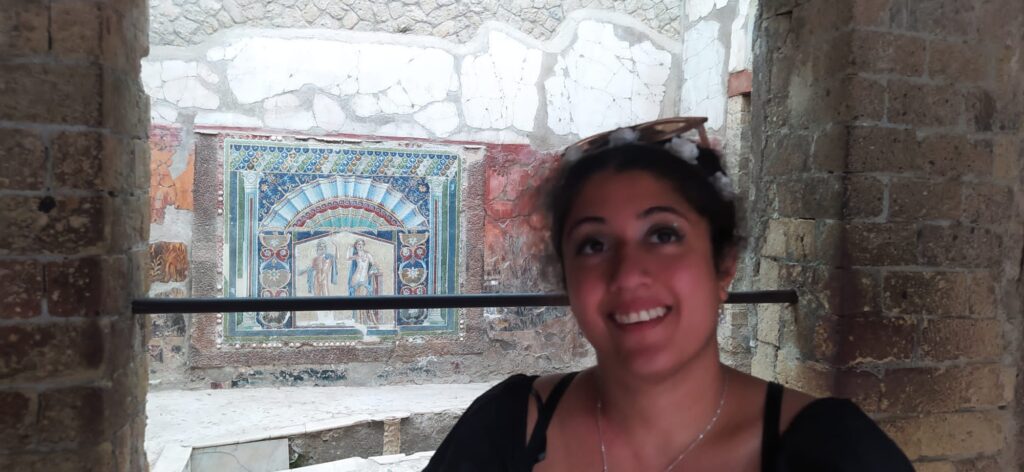
Alt text: image shows a girl with black hair, brown skin and glitter on her brown eyes in front of a beautiful fresco of Neptune and Amphitrite in vivid blues and carmine reds.
- Avoid the Metro and Use Buses wherever possible
As a general rule of thumb, when travelling in Napoli and Roma, it’s best to avoid the circle of Hell that is the underground metro stations. Most of the city centres in both these cities are not accessible, even when the little wheelchair symbol beside their name suggests they are.
In Napoli, we spent nearly two hours circling around because the station we attempted to get off at- Vanvitelli- had no working lift on one side of the platform- we had to wait for the next metro to the next stop, then go backwards to Vanvitelli to get to the other side which had a working elevator.
We were trying to see the magnificent views from Castel Sant’Elmo, and went to Vanvitelli to get the Central Funicular. On the way down, we took the wrong funicular, Montesanto, which is recommended in all the guidebooks, and is absolutely not accessible, with a very long steep flight of steps. Of Napoli’s four funiculars, only two are accessible: Chiaia and the Central Funicular; Mergellina is not. So, if you’d like to visit Castel Sant’Elmo, we would recommend not getting the Metro at all, and walking straight to the Central Funicular.
Likewise, we encountered the same problems in Rome when trying to get to Cinecittà and the Parco degli Acquedotti a little outside the city centre. None of the stations in the Centro Storico, including the Spanish Steps or even in the main station of Roma Termini, have accessible metro platforms. So do yourself a favour and avoid them entirely!
Thankfully, all the public buses we encountered in the four cities were accessible with manual pull-out ramps, and there are often two spaces for wheelchair users on buses, unlike in Dublin where only one is for a wheelchair and the other is designated for prams.
5. Be Prepared For Wheelchair Damage on Airlines
Yes, the all too common nightmare for disabled travellers finally caught up with me this September.
I never take my priceless electric chair on holidays with me- I have just heard too many horror stories of wheelchair damage. Although it would make our lives easier, granting me more independence instead of putting more strain on Jules and our relationship when he is forced to push me around on the much cheaper manual wheelchair I bring with me, I just don’t want to take the risk.
I was still too burnt-out after organising Ireland’s first Disability Pride Parade in July, to properly deal with the damage that was inflicted on my manual wheelchair after we arrived from our Ryanair flight to Verona. To be fair, it was so small but deadly that we didn’t at first notice it- all that is ultimately missing, is a small but crucial and near-impossible-to-replace screw. Jules conjectures that an attendant must have tried to remove the wheel, found that it was attached to the chair, and lost the screw when he forced it back in. By the end of our trip, the wheel of the chair was falling off constantly, a major pain for Jules. Although I bought the 35 euro annual Ryanair travel insurance, it was by then too late to make a claim.
Whether you are willing to take the risk of bringing along your electric chair or sticking to a cheaper manual (perhaps with one of those nifty powered attachments that some people have) make sure that you check it carefully when they give it back to you for any signs of damage and report it then and there in the airport, and within 24 hours. Make sure to check the terms and conditions of your insurance before your fly.
Bonus Tips: Three Things We Did Right That Everyone Should Know
If all of this has made you feel discouraged, this next tip may be the best consolation to make up for it.
- Bring A Proof of Disability for Free Entry Everywhere and Zero Queues
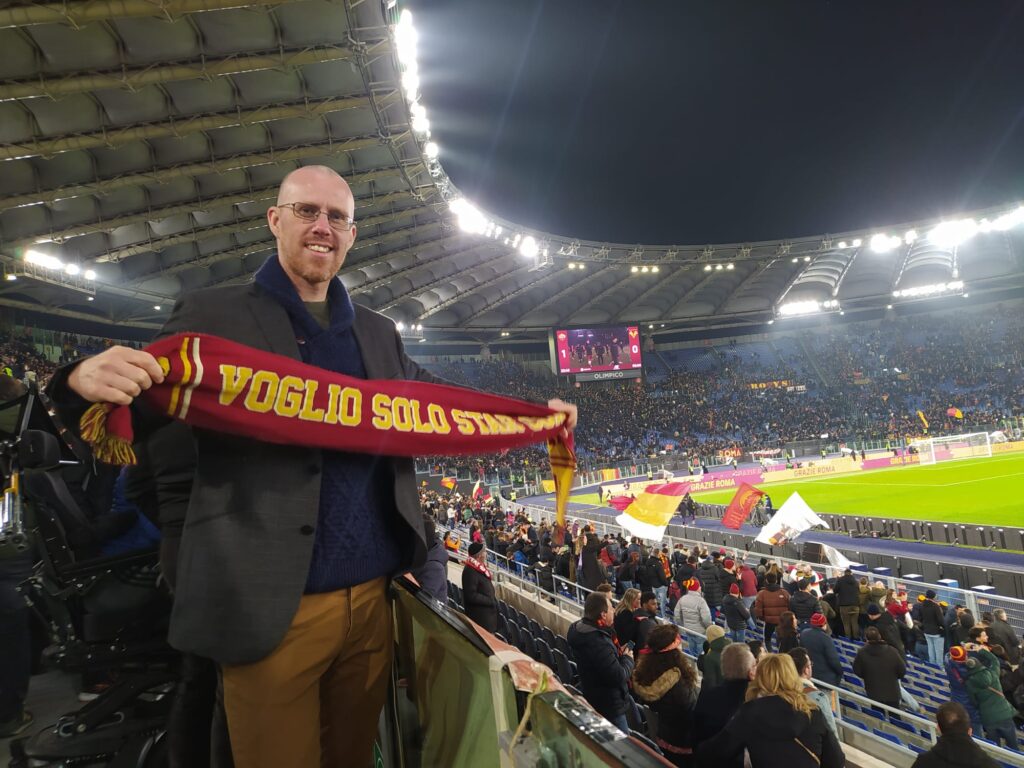
Italy, like Greece and many other European countries (but not Ireland- when did we stop doing this here?) gives free entry for disabled people and a companion to all museums and main attractions, apart from a very rare few that are privately owned. The queues that go all around the Colosseum and outside the Vatican walls? Don’t worry about them- you will skip straight past them to the ticket office. The 30 euro ticket and reservation price for the Uffizi Gallery to see the Birth of Venus? It’s free for you and your companion, and no time slots need to be booked- just go straight on in at anytime you fancy. Pompeii and Herculaneum? All free. Want to catch a football match with AS Roma at the Stadio Olimpico? It’s either free or heavily reduced for you and your companion, you just need to contact their call centre (you can message callcentre@asroma.it or call +39 0689386000).
The catch?
You must show proof that you are 100% disabled.
I know, such a thing does not exist. On occasions in Rome where I had left my proof of disability in the hotel (in my case I use my Irish disabled parking permit, you could also use a GP or occupational therapist’s letter if you don’t have one) I’ve angrily told doubtful ticket inspectors that the only way I could be 100% disabled is if I were dead.
It seems that 100% disabled refers to whether you are ambulatory or not, but not all attractions specify needing to be 100% disabled. In Verona and Napoli, we rarely had to show proof of disability- just showing up being visibly disabled in a wheelchair was enough, and we were hurried on in. But bringing some kind of proof will prevent you from being at the mercy of the decency of others. You may find some unexpected, extra kindnesses. In Da Michele, the restaurant made famous by Eat, Pray, Love for where it was deemed Napoli’s best pizza, we were also rushed in by the waiter who didn’t want us to partake in the 20 minute queue. Which brings us to the last tip that everyone, disabled or not, needs to be aware of in Italy
2, Book Everything You Can in Advance, Including Restaurants
This applies even more to non-disabled people, who should really book every attraction possible in advance online, such as your time slot in the Uffizi, Vatican and at the Accademia to see the David in Florence- you can also get multiple passes such as the Roma Pass. Disabled people and a companion usually go straight to the ticket office of the attraction to get a free ticket to enter on the spot. The only thing you might want to get in advance are any guided tours, and I recommend getting one when you book to see the Colosseum Underground. These can all sell out over a month in advance so book as early as you can.
Of all the many places we visited, the only fee we had to pay was 5 euro for Jules as my companion at Casa di Dante, and full price for a guided tour of Palazzo Farnese (which we haven’t seen yet for this reason).
A thing which catches most tourists off-guard is not having restaurant, rooftop bar or any sit-down meal reservations, which is the norm here, even during off-peak seasons. Italians appreciate their godly food, as do the rest of the world who fly in for the same renowned restaurants- queues for most high quality places are often far out the door, so to avoid having to resort to eating in tourist traps, book your table in advance online or by phone if you can. If you are in the area for a few days, stop by to book your meal in advance- you won’t regret it. The exception here is Napoli, as many of its most famous pizzerie are takeaways or don’t take reservations (the historical Pizzeria Brandi, which has some proof of inventing the first margherita, is an exception to this exception- you had best stop by to book in advance). In these cases, you may have to wait 20 minutes to an hour or more, like all the other foodies.
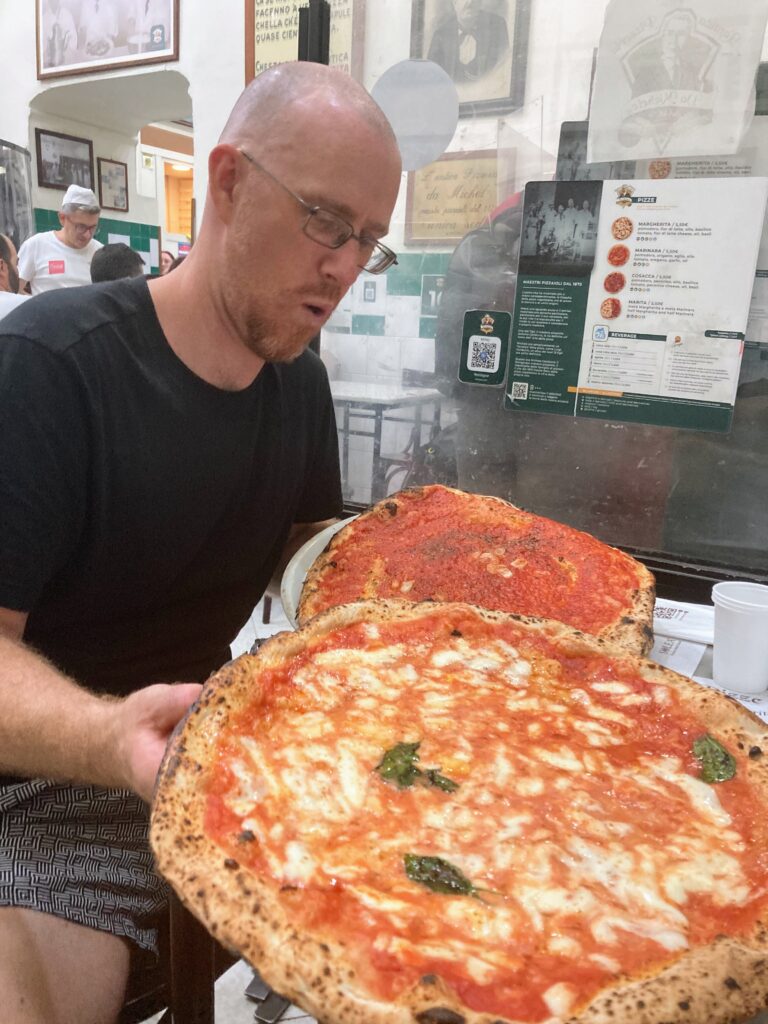
3. Check Opening Times Everywhere for the Day That Everything Closes
In the cities we’ve been to in Italy so far, there is always one or two days in which everything closes- usually that day is Monday or Tuesday, but a particular attraction or restaurant could choose to close on Sunday or Wednesday. Restaurants traditionally open between 12-3pm for lunch then close and open again from 7-10pm for dinner, while most gelaterie stay open until midnight or later- but opening hours are variable, so before you go anywhere, check which day and times it’s open!
And there you have it- arming yourself with this information should reduce the occurrence of unpleasant surprises, so that you can concentrate on enjoying your own trip of a lifetime, and savouring each and every sweet, sensual, incandescent and transcendently beautiful moment in the Bel Paese.

